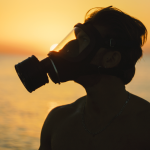Per-and Polyfluoroalkyl (PFA) may be added as an additive to plant-fiber-based food packaging to obtain grease/water fobidity. However, PFA is persistent, bioaccumulating and toxic. Polymers are less mobile and bioaccesible than non-polymeric PFA. However, impurities or their hydrolysis products are also of health concern. For instance, elevated PFA level in serum has been associated with microwave used for heating food packed with plastic bags where PFA has been added. Due to these concerns, some states in the USA have banned the use of PFA substances in food packaging. PFA thresholds have been established in different countries. For instance, Canada Probable Daily Intake (PDI) of 0.025 gKgbw-1d-1 has been imposed based on migration tests. Tolerable Weekly Intake (TWI) of 4.4 ngKgbw-1week-1 has been established in Europe.
Particle induced gamma ray emission spectroscopy has been used1 to measure PFA substances in Canadian food packaging used for fast foods, obtaining the following range of F containing: < 3800 μg F/m2 (55 % of samples), >10 800 μg F/m2 (26 % of samples) and the remaining 19 % of samples between the last values. Some of the PFC substances detected are: 1Perfluorocarboxilic acid (PFCA), 6:2 fluorotelomer Alcohol (FTOH) and 6:2 fluorotelomer methacrylate (FTMAc)
Neutral and volatile PFA substances have also been found2 in indoor air coming from food, water, air and dust. Therefore, inhalation is another via of PFA substances human intake. As a conclusion, it can be pointed out that the environmentally convenient use of plant-fiber-based food packaging could bring quite inconvenient health consequences if PFA substances are used as additives.

1.- Heather Schwartz-Narbonne, Chunjie Xia, Anna Shalin, Heather D. Whitehead, Diwen Yang, Graham F. Peaslee, Zhanyun Wang, Yan Wu, Hui Peng, Arlene Blum, Marta Venier, Miriam L. Diamond. Environ.Sci.Technol. Lett. 2023. https://doi.org/10.1021/acs.estlett.2c00926
2.- Maya E. Morales-Mc Devitt, Jitka Becanova, Arlene Blim, Thomas A. Bruton, Simon Vojta, Melissa Woodward, Rainener Lohmann. Environ.Sci.Technol. Lett. 2021, 8,10, 897-902.





